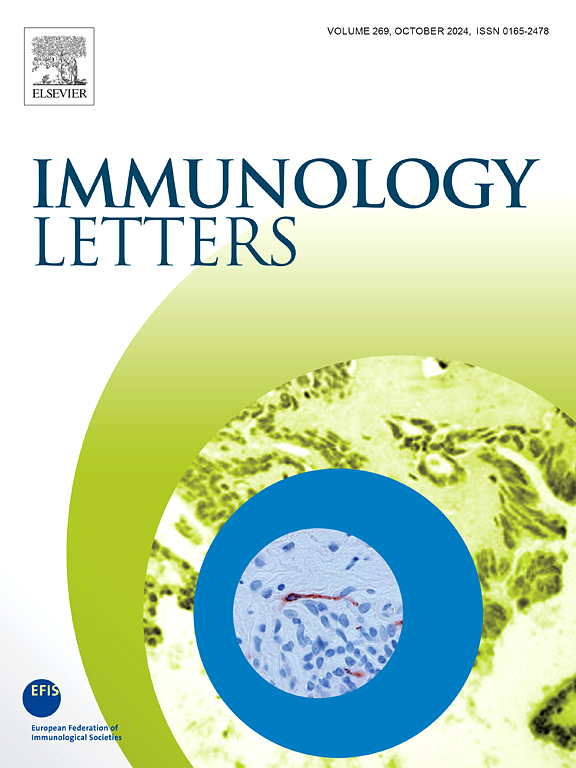The regulatory effect and molecular mechanism of Epstein-Barr virus protein LMP-1 in SLE susceptibility gene expression
IF 2.8
4区 医学
Q3 IMMUNOLOGY
引用次数: 0
Abstract
The development of systemic lupus erythematosus (SLE) involves both genetic and environmental factors. Epstein–Barr virus (EBV) infection has been implicated in SLE pathogenesis, particularly through the activity of latent membrane protein 1 (LMP-1). This study aimed to explore the role of LMP-1 in regulating susceptibility gene expression in SLE. Peripheral blood mononuclear cells (PBMCs) from SLE patients and H9 T cells were used to investigate this mechanism both in vivo and in vitro. RNA-seq analysis revealed that LMP-1 and the SLE susceptibility gene AT-rich interactive domain 5B (ARID5B) were significantly upregulated in SLE. Overexpression of LMP-1 in H9 T cells further increased ARID5B expression. Histone H3K27 methylation, catalyzed by enhancer of zeste homolog 2 (EZH2), was significantly elevated, suggesting epigenetic modifications play a role in this regulation. H3K27 methylation was studied due to its known involvement in transcriptional repression and chromatin remodeling in autoimmune diseases. Furthermore, phosphorylated p65 (p-p65), a marker of nuclear factor-kappa-B (NF-κB) pathway activation, was increased. Blocking the NF-κB signaling pathway reduced ARID5B expression, indicating that LMP-1 may regulate susceptibility genes through NF-κB signaling and histone modifications. These findings suggest that EBV LMP-1 contributes to SLE pathogenesis by epigenetically modulating susceptibility gene expression and activating inflammatory pathways.
Epstein-Barr病毒蛋白LMP-1在SLE易感基因表达中的调控作用及分子机制
系统性红斑狼疮(SLE)的发展涉及遗传和环境因素。eb病毒(EBV)感染与SLE的发病机制有关,特别是通过潜伏膜蛋白1 (LMP-1)的活性。本研究旨在探讨LMP-1在SLE易感基因表达调控中的作用。利用SLE患者外周血单核细胞(PBMCs)和H9 T细胞在体内和体外研究了这一机制。RNA-seq分析显示LMP-1和SLE易感基因AT-rich interactive domain 5B (ARID5B)在SLE中显著上调。LMP-1在H9 T细胞中的过表达进一步增加了ARID5B的表达。由zeste同源物2增强子(enhancer of zeste homolog 2, EZH2)催化的组蛋白H3K27甲基化显著升高,表明表观遗传修饰在这一调控中起作用。研究H3K27甲基化是由于其已知参与自身免疫性疾病的转录抑制和染色质重塑。此外,核因子κ b (NF-κB)通路激活标志物磷酸化p65 (p-p65)升高。阻断NF-κB信号通路可降低ARID5B的表达,提示LMP-1可能通过NF-κB信号通路和组蛋白修饰调控易感基因。这些发现表明EBV LMP-1通过表观遗传调节易感基因表达和激活炎症途径参与SLE发病。
本文章由计算机程序翻译,如有差异,请以英文原文为准。
求助全文
约1分钟内获得全文
求助全文
来源期刊

Immunology letters
医学-免疫学
CiteScore
7.60
自引率
0.00%
发文量
86
审稿时长
44 days
期刊介绍:
Immunology Letters provides a vehicle for the speedy publication of experimental papers, (mini)Reviews and Letters to the Editor addressing all aspects of molecular and cellular immunology. The essential criteria for publication will be clarity, experimental soundness and novelty. Results contradictory to current accepted thinking or ideas divergent from actual dogmas will be considered for publication provided that they are based on solid experimental findings.
Preference will be given to papers of immediate importance to other investigators, either by their experimental data, new ideas or new methodology. Scientific correspondence to the Editor-in-Chief related to the published papers may also be accepted provided that they are short and scientifically relevant to the papers mentioned, in order to provide a continuing forum for discussion.
 求助内容:
求助内容: 应助结果提醒方式:
应助结果提醒方式:


